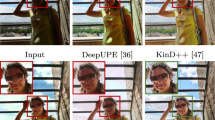Abstract
Image-based visualization is popular for various virtual tour applications, due to high-quality photorealism or simplicity for rendering. Stereo panorama representations of the virtual world are already a common part of this, either in small (computer screen) format or on large-scale stereo displays or screens. This paper discusses methods for determining optimum parameters, both for high-accuracy stereo panoramic image recording and displaying, with a special focus on automatic image disparity enhancement while displaying (e.g., including zooming) a stereo panorama. Experiments show that the discussed parameters are indeed critical for ensuring high-quality stereo viewing. Derived formulas in this study are applicable to various kinds of technologies for stereo panorama imaging or stereoscopic displaying.

















Similar content being viewed by others
Notes
This includes both crossed (i.e., negative, in front of the viewing medium) and uncrossed (i.e., positive, behind the viewing medium) disparity values.
Three CCD or CMOS lines, for red, green or blue channels, form the linear sensor-cell array.
In this paper we use length of a panorama rather than width of a panorama (as in earlier publications) because we will speak about the length of the circumference of the image cylinder.
These two values are symmetric with respect to the normal of the base circle, see Fig. 8.
The definition of a square pixel is actually only valid for a planar image surface. Imagine that the cylindrical capturing surface is unrolled and flattened; this defines a planar surface which allows to apply the Euclidean metric, but, it is, obviously, geometrically different to the original non-Euclidean capturing surface.
References
Chen C-W, Chan L-W, Tsai Y-P, Hung Y-P (2006) Augmented stereo panoramas. In: Proc. ACCV, LNCS 3851, pp 41–49
Chen SE (1995) Quick Time VR—an image-based approach to virtual environment navigation. In: Proc. SIGGRAPH, pp 29–38
Howard I, Rogers B (1995) Binocular vision and stereopsis. Oxford psychology series No.29. Oxford University Press, New York
Huang F, Klette R, Scheibe, K (2008) Panoramic imaging: sensor-line cameras and laser range-finders. Wiley, Chichester
Huang F, Klette R, Wei SK, Börner A, Reulke R, Scheele M, Scheibe K (2001) Hyper-resolution and polycentric panorama acquisition and experimental data collection. CITR-TR-90, Computer Science, The University of Auckland
Huang F, Wei S-K, Klette R (2001) Geometrical fundamentals of polycentric panoramas. In: Proc. ICCV, pp 560–565
Huang H-C, Hung Y-P (1998) Panoramic stereo imaging system with automatic disparity warping and seaming. GMIP 60:196–208
Ishiguro H, Yamamoto M, Tsuji S (1992) Omni-directional stereo. IEEE Trans Pattern Anal Mach Comm 14:257–262
Jiang W, Okutomi M, Sugimoto S (2006) Panoramic 3D reconstruction using rotational stereo camera with simple epipolar constraints. In: Proc. CVPR, vol 1, pp 371–378
Kawanishi T, Yamazawa K, Iwasa H, Takemura H, Yokoya N (1998) Generation of high-resolution stereo panoramic images by omnidirectional sensor using hexagonal pyramidal mirrors. In: Proc. ICPR, pp 485–489
Konrad J (1999) Enhancement of viewer comfort in stereoscopic viewing: parallax adjustment. In: Proc. SPIE vol 3639, pp 179–190
KST (2008) KST Eyescan M3D. http://www.kst-dresden.de/produkte.php?site=25&lang=en&katid=3
Murakami M (2006) StereoMaker and stereo panoramas. http://www.stereomaker.net/eng/
NASA (1998) Mars Pathfinder. http://mars.jpl.nasa.gov/MPF/vrml/qtvr_stereo.html
NASA (2007) STEREO project. http://www.nasa.gov/mission_pages/stereo/main/
Nayar S (1997) Catadioptric omnidirectional cameras. In: Proc. CVPR, pp 482–488
Humboldt-Universität zu Berlin (2005) Panoramic Photogrammetry Workshop. http://www2.informatik.hu-berlin.de/sv/pr/PanoramicPhotogrammetryWorkshop2005/
Panoscan (2008) Panoscan MK-3. http://www.panoscan.com/MK3/
Peleg S, Ben-Ezra M (1999) Stereo panorama with a single camera. In: Proc. CVPR’99, pp 395–401
Peleg S, Pritch Y, Ben-Ezra M (2000) Cameras for stereo panoramic imaging. In: Proc. CVPR, pp 208–214
Reulke R, Scheele M (1998) Der drei-Zeilen CCD-Stereoscanner WAAC: Grundaufbau und Anwendungen in der photogrammetrie. Photogramm Fernerkund Geoinf 3:157–163
Seitz S, Kim J (2002) The space of all stereo images. Int Computer J Vision 48:21–38
Shum H-Y, He L-W (1999) Rendering with concentric mosaics. In: Proc. SIGGRAPH, pp 299–306
Shum H-Y, Szeliski R (1999) Stereo reconstruction from multiperspective panoramas. In: Proc. Int. Conf. Computer Vision, pp 14–21
Stürzl W, Mallot HA (2002) Vision-based homing with panoramic stereo sensor. In: Proc. BMCV, LNCS 2525, pp 620–628
Valyrus N (1966) Stereoscopy. Focal, London
Viire E (1997) Health and safety issues for VR. Comm ACM 40:40–41
Wang C, Sawchuk AA (2006) Region based stereo panorama disparity adjusting. In: Proc. MMSP, pp 186–191
Ware C, Gobrecht C, Paton M (1998) Dynamic adjustment of stereo display parameters. IEEE Trans Syst Man Cybern 28:56–65
Wei S-K, Huang F, Klette R (1999) Three-dimensional scene navigation through anaglyphic panorama visualization. In: Proc. CAIP, LNCS 1689, pp 542–549
Acknowledgements
This project is partially sponsored by the National Science Council, Republic of China, November 2006, (grant no. NSC 95-2218-E-197-001). Both authors thank colleagues at DLR Berlin-Adlershof for collaboration and support, especially with respect to data and experiments.
Author information
Authors and Affiliations
Corresponding author
Rights and permissions
About this article
Cite this article
Huang, F., Klette, R. Stereo panorama acquisition and automatic image disparity adjustment for stereoscopic visualization. Multimed Tools Appl 47, 353–377 (2010). https://doi.org/10.1007/s11042-009-0328-2
Published:
Issue Date:
DOI: https://doi.org/10.1007/s11042-009-0328-2




